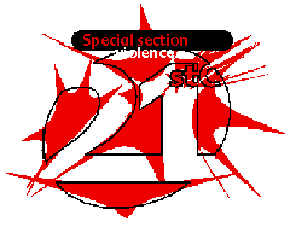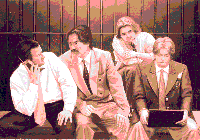

VIOLENCE
WHEN PEOPLE IN mainstream America think of violence, they also
think of poverty: the deviant, defiant, dangerous "underclass" or "undeserving poor." Such
stereotypes contain a grain of truth amid their untruths. Bad apples exist in all classes, from
muggers among the poor to manufacturers of defective products among the wealthy; nothing
in this analysis is intended to deny the existence of undeserving people. (It is interesting that
no one ever complains about an undeserving middle class.) But notions like undeservingness
take on an existence independent of the specific behaviors they describe, often broadening
into labels and stereotypes that gloss over useful distinctions. The attitudes that such labels
reflect and reinforce have political ramifications, some of which exacerbate poverty in their
own right.
In this mixture of fear,
anger, and disapproval, fear is perhaps the most important element. The threat to safety
blends into other threats to cultural standards, economic positions, and moral values,
justifying blanket measures (e.g., increasing life imprisonment) that do little to diminish
violence but increase the distance between the so-called underclass and the remainder of
society. The poor are the major victims of street crime, but mugging, robbery, and
pickpocketing are particularly threatening to everyone because they involve invasions of
intimate personal space. (Auto theft, probably the most pervasive of urban and suburban
crimes, is treated as less threatening.)
Fear makes people less willing to distinguish between actual and imagined threats and more
willing to listen to politicians who promise harsh reprisals. Local news media rarely miss the
most dramatic incidents, especially in white neighborhoods. (Researchers have long argued
that the emphasis on crime news is connected to the publicity needs of police departments,
especially at budget times, but news organizations also respond to perceived audience
interest.) The media rarely explain why crimes have taken place, adding to the sense of
randomness and senselessness.
Some findings suggest that the fear of crime is partly imagined. National polls report that the
percentage of people feeling safe in their own neighborhoods has not changed since the
mid-1970s, even though the same people believe that crime has increased significantly
both in the country and in their own community "over the past year."(4) Clearly, people fear something; they express this as fear of
crime, but it may be in part displaced fear of socioeconomic uncertainty, political inefficacy,
and cultural conflict.
The real fears that safety threats evoke easily spread to the non-criminal poor. Where
homeless people and panhandlers proliferate, the better-off perceive begging and
acting-out (misuses of their public space) as threats≠≠even if the danger is often
imagined, since the homeless are largely passive and beggars rarely attack their benefactors.
Since beggars generally outnumber criminals, a possible threat from the latter thus turns into
a more visible imagined threat from the former. Vagabonds and tramps evoked similar
responses in the rural communities of past centuries.
Moreover, apprehensiveness spreads to innocent people who look like street criminals to the
better-off, especially poor black young males≠≠probably the major targets of imagined
threats in America today(5)≠≠especially when they resort to
"oppositional" lifestyle signifiers: gangsta rap, distinctive dress codes, and general adolescent
swagger. These are essentially cultural threats, not so much an attack on adults as youth
culture's rather conventional attempt to keep adults at a distance. Again, there are historical
parallels: At the turn of the century, innocent immigrants from groups with high arrest rates
for the street crimes of the day≠≠the ancestors, incidentally, of today's "white ethnics" were also
viewed as cultural safety threats.
Fears of street crime must be understood as particular cases of more general class and race
fears, which go far beyond issues of safety. Yet since the perception of undeservingness
depends in part on violence, effective crime reduction would undoubtedly help to reduce the
political scapegoating of the poor, improving their lives both directly and indirectly. If the
nation is ever to take effective action against poverty≠≠neither the 1960s' federal "Skirmish on
Poverty," as those of us involved called it, nor today's counterproductive punitive
approaches≠≠non-poor citizens must consider the poor sufficiently deserving to merit
job-centered policies. But first, America must end the terrible scarcity of jobs open to
low-income people.
To break the dubious dichotomy in which the Right blames the poor and the Left blames
society, we need less blaming (justified or otherwise) and more policy-focused research
into the empirical causes of crime and the (self-) selection of some poor people to turn
to violence. More attention should be paid to the relation between ideology and fact, and
researchers can insist on empirical study for questions that can be answered empirically.
Either street crime is primarily caused by poverty and unemployment, or it is not; this need
not be a matter of permanent debate. After all, the middle and upper classes do not mug.
Ultimately, violent crime will not decline until enough Americans realize that punitive
measures have not worked. But until the actual threats decline significantly, imagined and
displaced threats are not likely to be reduced either. The political, and tragic, reality is that
mainstream America appears to be unwilling to give the poor a chance at decent
full-time jobs until safety threats decline. The poor, however, need the jobs first.
Otherwise, the lure of the streets will be too strong, and the incentive to move into seemingly
secure and well-paying criminal occupations too great.
Dugdale, R. L., "The Jukes": A Study in Crime,
Pauperism, Disease and Heredity (New York: Putnam's, 1875); Goddard, Henry H.,
The Kallikak Family (New York: Macmillan, 1912) and
Feeblemindedness (New York: Macmillan, 1914). Severe methodologic flaws in
Goddard's work— including the doctoring of photographs to make members of the Kallikak
family look more threatening—are analyzed in Gould, Stephen Jay, The Mismeasure of
Man (New York: Norton, 1981), pp. 172-174.
Lewis, Oscar, "The Culture of Poverty," in Moynihan,
Daniel P., ed., On Understanding Poverty (New York: Basic Books, 1968), pp.
187-200.
Berke, Richard L., "Fears of Crime Rival Concern Over
Economy," New York Times, Jan. 23, 1994, Section 1, pp.1,16. 73 percent
thought crime had increased in the country and 58 percent in their community, although the
interpretation of the polls is hampered by their lack of specificity about "crime."
For the definitive ethnographic analysis of this
phenomenon, see Anderson, Elijah, Streetwise: Race, Class and Change in an Urban
Community (University of Chicago Press, 1990), ch. 6.
ILLUSTRATION CREDIT: MARIO LOBO
AND POVERTY:
Images and realities of the "underclass"
Social labeling≠≠the resort to imagined knowledge to make moral judgments, differentiating
some people pejoratively≠≠has a long historical context. America has inherited much of its
labeling tradition from England. From the 14th century, when the centralized church
conferred responsibility for the English poor on local parishes and a new category of
"unworthy poor" was recognized,(1) to the 19th, when the
terms "deserving" and "undeserving" entered the language in connection with the 1834 Poor
Law, to today, when Gunnar Myrdal's non-pejorative economic term "underclass" has
been transformed into behavioral and hereditarian categories that Myrdal would scarcely
recognize, Anglo-American social beliefs have continually dichotomized the poor.
Along with their supposed laziness, feeblemindedness, and debauchery, the undeserving poor
are considered prone to violence. Whether this is based on beliefs in inherited deviance (as
propagated by 19th century genealogist Richard Dugdale and early 20th century
eugenicist/psychologist Henry Goddard(2)) or in a "culture of
poverty" (Oscar Lewis' famous term(3)), this perception
provides a rationale for scapegoating. It is remarkably consistent over time: The
characterization of the undeserving poor (the one thing all other strata of society agree on)
has changed remarkably little over at least 500 years. Undeservingness is not simply a
problem of modernity or postmodernity, capitalism or socialism. 
Webb, Sidney and Beatrice, English Poor Law
History (Hamden, Conn.: Shoe String Press, 1963 [1927]), pt. I, pp. 7 ff.
HERBERT J. GANS is Robert S. Lynd Professor of Sociology at
Columbia; a former president of the American Sociological Association; and the author, most
recently, of The War against the Poor: The Underclass and Antipoverty Policy
(NY: Basic Books, 1995), from which this article is adapted.




